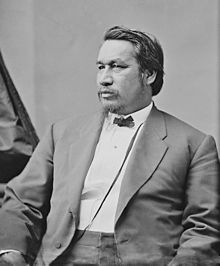
Back مكتب الشؤون الهندية Arabic Bureau of Indian Affairs Catalan Bureau of Indian Affairs Czech Bureau of Indian Affairs English Oficina de Asuntos Indígenas Spanish اداره امور سرخپوستان Persian Bureau of Indian Affairs Finnish Bureau des affaires indiennes French Buro fan Yndiaanske Saken Frisian Bureau of Indian Affairs Galician
| Bureau of Indian Affairs — BIA — | |
|---|---|
 | |
| Staatliche Ebene | Bund |
| Aufsichtsbehörde(n) | Innenministerium der Vereinigten Staaten |
| Bestehen | seit 1824 |
| Hauptsitz | Washington, D.C. |
| Behördenleitung | Bryan Newland, Bureau Director |
| Mitarbeiter | 4569 (FY2020) |
| Haushaltsvolumen | 2,159 Mrd. (FY2021)[1] |
| Website | www.bia.gov |




Das Bureau of Indian Affairs (BIA; deutsch „Amt für indianische Angelegenheiten“) ist eine dem Innenministerium der Vereinigten Staaten unterstellte Behörde, die sich um die Belange der Indianer und deren Reservate kümmern soll. Sie wurde im Jahre 1824 gegründet und war damals noch dem Kriegsministerium der USA unterstellt. 1849 wurde sie dem neu entstandenen Innenministerium zugeordnet. Es ist damit das älteste Amt des Innenministeriums. Nach eigenen Angaben betreut das BIA 567 von der Bundesregierung anerkannte Indianerstämme, mit 1,9 Millionen Mitgliedern. Das BIA verwaltet 55 Millionen Acres (225.000 km²) Land im Auftrag der Indianerstämme. Zirka 42.000 Schüler besuchen 183 BIA-eigene Schulen. Auch betreibt oder unterstützt das Amt 28 Universitäten und Fachhochschulen.[2][3] Sitz der Behörde ist Washington, D.C. Das Amt befindet sich zurzeit im Umbruch. Stand in der Vergangenheit die Verwaltung und Überwachung der amerikanischen Ureinwohner im Vordergrund seiner Aktivitäten, so möchte das Amt heute helfen, die Lebensbedingungen der indianischen Bevölkerung zu verbessern. Dieser Umbruch ist schwierig, sehen doch viele Indianer das BIA als die Ursache ihrer Probleme. Auch fiel das BIA in der Vergangenheit durch massive Korruptionsfälle negativ auf.[4][5]
- ↑ Congressional Research Service: The Bureau of Indian Affairs: FY2021 Appropriations
- ↑ There are 567 federally recognized American Indian tribes and Alaska Natives in the United States. Bureau of Indian Affairs (BIA) is responsible for the administration and management of 55 million surface acres and 57 million acres of subsurface minerals estates held in trust by the United States for American Indian, Indian tribes, and Alaska Natives. Bureau of Indian Education (BIE) provides education services to approximately 42,000 Indian students. ( vom 19. Juli 2017 im Internet Archive)
- ↑ Programs administered by either Tribes or Indian Affairs through the Bureau of Indian Education (BIE) include an education system consisting of 183 schools and dormitories educating approximately 42,000 elementary and secondary students and 28 tribal colleges, universities, and post-secondary schools ( vom 22. August 2017 im Internet Archive)
- ↑ The tribes' relationship with the bureau is often described as a love/hate relationship. On the one hand, the bureau is the symbol of the tribes' special relationship with the federal government. On the other hand, tribes have suffered from bureau mismanagement, paternalism, and neglect. It is the hope and objective of many tribal peoples and government officials that tribes can enter into a more equal relationship with the bureau and that the bureau can truly function in an advisory capacity as opposed to dictating policy to tribes.
- ↑ The BIA is currently involved in a lawsuit over its mismanagement of Individual Indian Monies (IIM) trust accounts. The suit was brought against the BIA and the federal government by Elouise Cobell and other individual Native Americans in 1996.